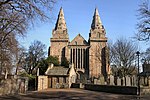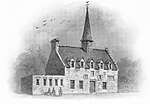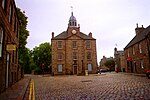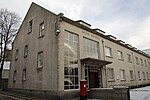The origin of the Diocese of Aberdeen is unclear although Hector Boece, a 16th century scholar, used unconvincing early charters to develop a history of the diocese. He described how a succession of 11th century bishops—Bean, Denortius and Cormac—were the first bishops of Mortlach. Boece then allowed a fourth Mortlach bishop, Nectan, to translate the see to Aberdeen in the first quarter of the 12th century. That the first bishop of Aberdeen was Nectan is conclusive but his emergence as described by Boece is dubious. Nectan’s appearance as a note in the Book of Deer is undisputed and places him to c. 1132. The diocese was formed in the early part of the 12th century during changes in ecclesiastical authority. The papal bull of 1157 to Bishop Edward is the first direct documentary evidence of a bishop at Aberdeen. It referred to his cathedral and its proposed chapter and marked the beginning of the expansion of the diocesan organisation.
The national development of the parochial system accelerated under David I (1124-1153) although he can't be credited with its concept which had pre-existed in Scotland, as elsewhere, since the earlier middle ages. David formalalised the rights of the parish church, both territorially and legally. His reforms ensured that parishioners could sustain their priests by the provision of teinds. Church building and the supply of priests lay with local lords, just as they had always done, and who continued to exert their rights of patronage. To see themselves safely into the afterlife, the cadre of landowners granted the patronage of most of the churches either to the cathedral or to a monastery of choice. This now provided the opportunity for the substantial appropriation of the fruits of the parish churches to the major religious institutions. Consequently, the parish churches became impoverished both in terms of their sustenance and the quality of the priesthood. In most cases, cathedral annexations were of both the parsonages and the vicarages leaving a pensioned vicar, often uneducated, to provide for the cure of souls. The annexed churches formed prebends for the chapter and dignitaries of the cathedral. The prebendary then assumed the responsibility of adequate vicarage provision.
Over time, the chapter increased its numbers requiring further parish church annexations. Reconstruction of the cathedral began in the late 14th century and continued up to the 16th century.








